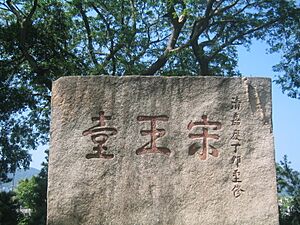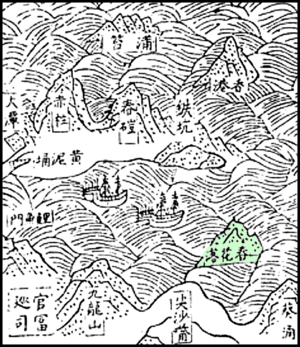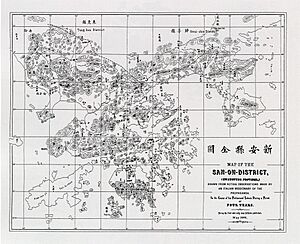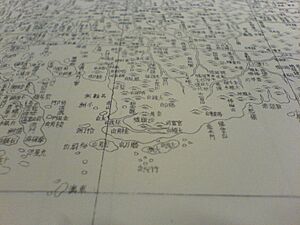History of Hong Kong under Imperial China facts for kids
The history of Hong Kong under Imperial China began in 214 BC during the Qin dynasty. For a long time, the area was mostly empty. Later, near the end of the Qing dynasty, Imperial China gave Hong Kong to Great Britain. This happened in 1842 with the Treaty of Nanking. After that, Hong Kong became a British Colony.
Contents
Early History: Before 200 AD
Before the Qin dynasty, the Hong Kong area was home to many non-Chinese groups. These were known as the Yue people. We don't know much about them. Most of what we know comes from old Chinese writings and digs by archaeologists. Their language might have been Austroasiatic.
Around 221 BC, the First Emperor of the Qin dynasty united China. He then sent a large army to take over the Yue tribes. In 214 BC, the Qin armies won. The area that is now southern China became part of the Qin empire. The Qin dynasty divided its land into "commanderies." These were like today's provinces. The area of today's Guangdong and Hong Kong became part of the Nanhai Commandery.
The First Emperor died in 210 BC. This led to many rebellions across China. Zhao Tuo, a Chinese general, had marched south with the Qin army. He started his own kingdom called Nanyue. Its capital was at Panyu (modern Guangzhou). Nanyue was a successful kingdom. Its rulers were mostly Han Chinese. Many local Yue people served as leaders and officials. Old items from this time have been found near Guangzhou. But none have been found in Hong Kong yet.
The Han dynasty conquered Nanyue around 112 BC. This happened after the Han–Nanyue War. In the 1950s, a tomb at Lei Cheng Uk was found. It dates from the Eastern Han dynasty (25–220 AD). Items in the tomb made some experts think that salt was made a lot in the area back then. But we need more proof. The first Han Chinese people likely settled in Hong Kong during this time.
Tang Dynasty: A Trading Hub (618–907 AD)
During the Tang dynasty, the Guangdong region became a busy place for international trade. The Tuen Mun area, which is now in Hong Kong's New Territories, was an important spot. It served as a port and a naval base. It was also a place where salt was made. Later, it became a base for finding pearls. Lantau Island was another place where salt was produced. Salt smugglers even caused riots there against the government.
Song Dynasty: New Settlements (960–1279 AD)

The oldest known writing about an event in Hong Kong is a stone carving. It has 108 characters and is now a protected monument. It is found at the southern tip of a peninsula in Joss House Bay. The carving talks about building a stone pagoda on nearby Tung Lung Island. This happened in 1012 AD, during the reign of Emperor Zhenzong of Song of the Northern Song dynasty. The carving itself was made in 1274 AD. This makes it the oldest historical item in Hong Kong and Kowloon with a clear date.
During the Northern Song dynasty, village schools were set up. One example is Li Ying College, started around 1075. These schools in the New Territories taught students for the Imperial Chinese education system.
In 1276, the Mongols invaded China. The imperial court of the Southern Song dynasty moved to Fujian. Then they moved to Lantau Island and later to today's Kowloon City. By the end of the Song dynasty, the first big family group to arrive was the Tang's (Deng, 鄧). They mostly settled in the valleys and flat areas of the New Territories.
Yuan Dynasty: Growing Population (1271–1368)
During the Mongol-led Yuan dynasty, Hong Kong's population grew a lot. This was because many Chinese people moved there as refugees. Five main families are said to be among the first settlers in Hong Kong. These were the Tang (Deng, 鄧), Hau (Hou, 侯), Pang (Peng, 彭), Liu (Liao, 廖), and Man (Wen, 文). Even though more people arrived and some farming began, the area was still quite empty. People relied on making salt, finding pearls, and fishing to earn money.
Ming Dynasty: First European Visitors (1368–1644)

In the early 1500s, Hong Kong had its first recorded non-Asian visitor. This was Portuguese sailor Jorge Álvares in 1513. After Álvares settled in Hong Kong, Portuguese merchants started trading in Southern China. At the same time, they built military forts in Tuen Mun. This led to fights between China and Portugal, and the Portuguese were forced to leave. However, the Portuguese later started trading again by 1549. They sent yearly trade missions to Shangchuan Island. Thanks to the efforts of Leonel de Sousa, they got permission to set up a trade colony in Macau in 1557.
In the mid-1500s, the maritime prohibition policy began. This rule was meant to stop contact with foreigners. It also limited local sea activities. Villagers in Hong Kong's coastal areas were told to move to mainland China. The change from the Ming dynasty to the Qing dynasty also led to rebels being forced out. Qing officials made many Hong Kong villagers go back to the mainland. They did this by destroying villages and crops, which caused hunger.
Hong Kong was governed as part of Xin'an County (新安縣) during the Ming dynasty.
Qing Dynasty: The Great Clearance (1644–1842)
From 1661 to 1669, the area was affected by the Great Clearance. This was an order from the Qing dynasty's Kangxi Emperor. It required people to leave the coastal areas of Guangdong. About 16,000 people from Xin'an County were forced to move inland. When the order was cancelled in 1669, about 1,648 of them came back. The area that is now Hong Kong became mostly empty during this ban.
The Hakka people became the main group to settle the area. Today, they are a big part of Hong Kong's culture. Many traditional Hakka villages are still found in the New Territories. Hakka people are a special group with their own unique food. They have many traditional and famous dishes.
Henry Pottinger came to Asia in 1841. He later became the first Governor of Hong Kong under British rule in 1842. This marked the end of Imperial China's control over Hong Kong.
See also
- Walled villages of Hong Kong




